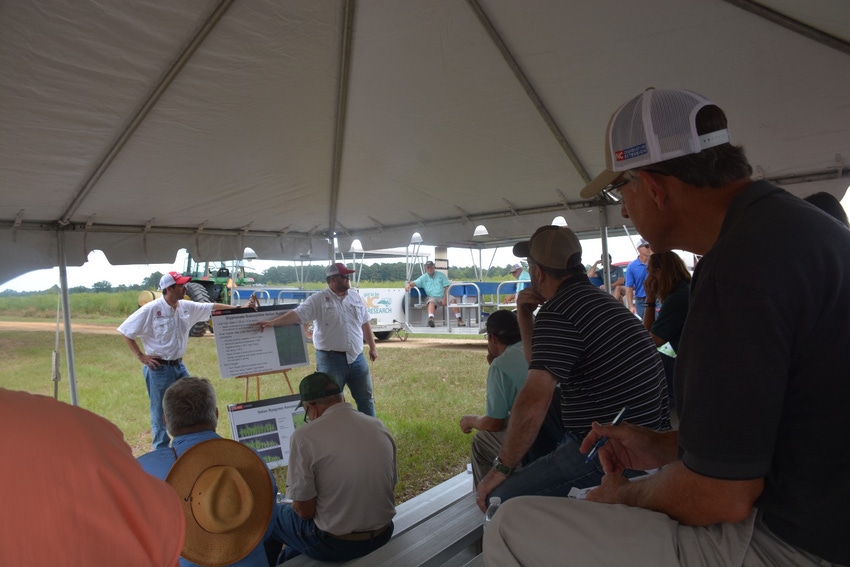
Charlie Cahoon urges North Carolina farmers to be on the lookout for herbicide-resistant Italian ryegrass that is becoming a bigger issue across the state.
Speaking at the Cotton Field Day Sept. 16 at the Upper Coastal Plain Research Station in Rocky Mount, Cahoon, North Carolina State University Extension weed specialist for corn and cotton, noted that herbicide-resistant Italian ryegrass has long been a problem for farmers in the North Carolina Southern Piedmont and is now becoming more of an issue for farmers in eastern North Carolina as well.
“We have long battled Italian ryegrass resistance in the state. We selected for ALS- and ACCase-resistant ryegrass in small grain production many years ago. Then we selected for glyphosate-resistant ryegrass when targeting the weed preplant burndown,” Cahoon told field day attendees.
Cahoon said he knows there is glyphosate-resistant Italian ryegrass in the Southern Piedmont and in eastern North Carolina. He stressed that if farmers see resistance to both glyphosate and ALS inhibitors, they will need to take a different approach..
Cahoon said his and Wesley Everman’s, North Carolina State University Extension weed specialist, phones are ringing off the hook with calls from farmers complaining that Italian ryegrass was not controlled this past spring. He said the key to control is using the right rates and to make sure the Italian ryegrass is actively growing and that temperatures are warm.
“When using glyphosate, we should use at least 1.25 pounds acid equivalent to the acre. We also want the Italian ryegrass to be actively growing for five to seven days. If it gets below 38 degrees, we want to wait a couple of days. We’d also like to have a lot of sunlight by getting that application on in the heat of the day, especially if cooler temperatures prevail.,” Cahoon said.
The good news is ACCase-resistance is not as widespread in eastern North Carolina compared to the Southern Piedmont. Cahoon said it is important to remember when applying ACCase inhibitors that larger Italian ryegrass can be difficult to control.
So, the question remains: What can farmers do for glyphosate-, ALS-, and ACCase-resistant Italian ryegrass? Cahoon says the answer is paraquat.
“People are taken aback when I recommend a contact herbicide for a grass. But really, if we are dealing with multiple resistant ryegrass, paraquat is our last line of defense for controlling emerged Italian ryegrass. Folks in the Southern Piedmont have been doing that for the last seven or eight years. They’ve been forced to switch to paraquat over most of their acres because a lot of it is glyphosate-resistant,” Cahoon said.
If a farmer has glyphosate-resistant Italian ryegrass and wants to switch to paraquat, Cahoon said it’s important to remember that paraquat is a contact herbicide and steps must be taking to maximize its activity.
“We need good spray coverage. We’re recommending at least 15 GPA (gallons per acre). More would be better. We need medium to small droplets. We also want the ryegrass to be small, four inches or less. That is not in March or April. That’s like in February at the latest,” Cahoon said.
“We can slow down the activity of paraquat by adding something like atrazine if you’re planting corn or metribuzin if you’re planting soybeans or diuron if you’re planting cotton. We get better efficacy when we make that tank-mix with paraquat. It slows down the activity; it , gives the paraquat a little more time to move and does a little bit better job controlling that ryegrass,” Cahoon said.
However, Cahoon reminded the crowd to not get complacent using just paraquat for Italian ryegrass control.
“Preliminary research from PhD student Jose DeSanctis confirms we now have paraquat-resistant Italian ryegrass in the state. If we are dealing with a four-way biotype resistant to paraquat, glyphosate, ALS-, and ACCase-inhibiting herbicides, we have no viable options to control emerged Italian ryegrass,” Cahoon said.
Cahoon and Everman are currently searching for solutions for multiple-resistant Italian ryegrass that include residual herbicides in combination with cover crops and harvest weed seed control.
“The best way to deal with paraquat-resistant Italian ryegrass is to never let it on your farm. That means you will have to voluntarily employ tactics farmers battling paraquat-resistance have been forced to do,” Cahoon said.
About the Author(s)
You May Also Like






